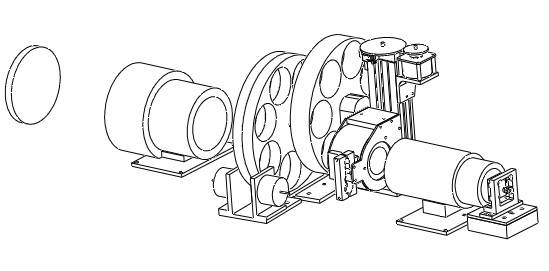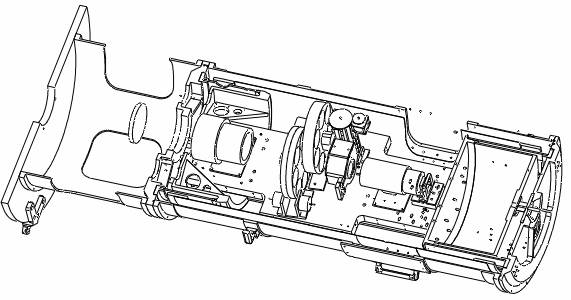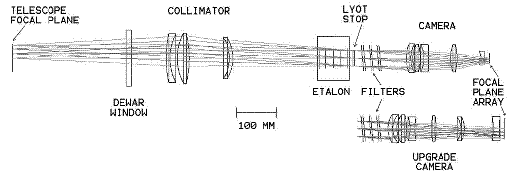
Relevant Documents:
Technical Overview:
Physical Layout:

The physical layout of the optical components (left to right) shows the entry
window, collimator housing (3 lenses),
double and single filter wheels, etalon and etalon mover, camera housing (5 lenses) and focal plane array.

Cross-sectional view of the instrument shows (left to right) mounting plate, front housing, and main housing
containing loaded optics bench and liquid nitrogen tank. Two doors to allow access to both sides of the
focal plane array.
-Instrument mounts on the Nasmyth 2 telescope port. Port has its own rotator and guider.
-Cool dewar interior to ~77 K using LN2. 24+ hour hold time.
-Dewar is able to rotate 360 degrees in either direction without affecting optical alignment, cooling, or external connections.
General Optical:

Optical layout of NIC-FPS. Dewar (entrance) window is the boundary of the vacuum volume. Other components
are operated near LN2 temperature. Etalon is shown in the full-field spectroscopy position and is retracted
for the imaging mode. Note that the as-built system swaps the locations of the etalon and filters on the sides of
the Lyot stop due to physical space limitations on the optical bench. The upgrade camera is a potential future
enhancement to a 2k x 2k detector.
-Wavelength range is .85 to 2.5 microns
-Compatible with ARC 3.5 m telescope's F-10.35 beam speed at the Nasmyth 2 mounting port.
-High intrinsic Strehl (>90% encircled within 0.5" radius) to preserve optimum image quality in
excellent seeing at
2 microns.
-3.5 meter telescope diffraction limit at 2 microns is 0.28" diameter.
-Lyot stop at re-imaged pupil plane to block secondary mirror thermal emissions from areas beyond the primary mirror.
Fabry-Perot Etalon:
-Cryogenic Fabry-Perot etalon: R ~ 10,000 etalon, or ~ 30 km/s. Finesse ~ 36.
-Free-spectral range of ~ 0.3% or ~ 900 km/s.-Etalon wavelength range 1.4 - 2.4 microns. Operational wavelength range set by available order-sorter filters.
-Etalon is a Queensgate model EC50WF. Etalon has a 50 mm free aperture and 244 micron gap and
is be fed with a collimated 40 mm diameter beam.-External lamp(s) for etalon wavelength calibration.
Detector Array:
-0.27"/pixel for 1024 x 1024 HgCdTe detector yields field of view of 4.6' x 4.6' edge-to edge. 6.4' corner-to-corner.
-3 pixel sampling of nominal seeing conditions of ~0.8" FWHM at 2 microns.
-2 pixel sampling of ~0.5" FWHM seeing at 2 microns.-Minimized (1.6%) and well-characterized image distortion to support accurate astrometry-Rockwell Hawaii 1RG 1024 x 1024 HgCdTe detector with 18 micron pixel pitch, 1016 x 1016 pixel active area.
-4 reference pixels around the perimeter for direct measurement of bias level and read noise.
-Quantum efficiency greater than 65%, well capacity at least 6x10^4 electrons, read noise less than 5 electrons and dark current less than one electron per second.
-Two channel readout.
-Optimized for low read noise and low dark current for long exposures of faint objects.
-Postage stamp non-destructive readout for rapid imaging of small area and bright objects (window mode).
Distortion Mapping (Word doc)
Bad Pixel Mapping (Word doc)
Filter System:
-3 motorized filter wheels with 7 x 65 mm slots each placed at 5 degrees to prevent
ghosting
-16 slots available for filters. 1 slot for grism. 1 blank for dark frames.
-Broad: R ~ 5 J, H, K short. JHKs filters are of the Mauna Kea Filter Set standards were provided by Barr Associates.
-Medium: R ~ 20 filters for photometric redshifts. Low priority.
-Narrow: R ~ 10 filters for narrow-band imaging of selected emission lines, plus nearby off-band matching filters for
sky-subtraction.
-NIC-FPS will not require refocusing when changing bandpasses.
Narrow Band Filter Specifications
NIC-FPS Sensitivity Estimates:
Estimated 5 sigma detection limit over a 4x4 pixel aperture
|
Band |
1 second |
1 minute |
1 hour |
|
Z |
18.7 |
21.0 |
23.2 |
|
J |
18.0 |
20.3 |
22.5 |
|
H |
16.7 |
18.9 |
21.2 |
|
K |
16.0 |
18.3 |
20.5 |
Estimates are for time on target only, and do not include overhead due to readouts or sky subtraction.
Estimates are for system throughput of 0.5.
Estimated sky saturation times for J, H, K bands are 50, 5 and 5 seconds, respectively.

Raytracing by Mark Vincent and Carl A. Schmidt.
Optical design by Chris Stewart of Ball Aerospace.